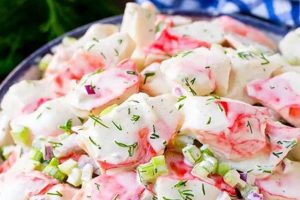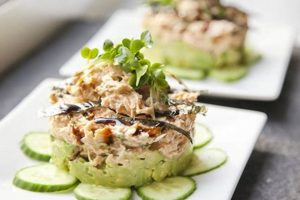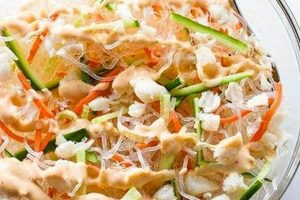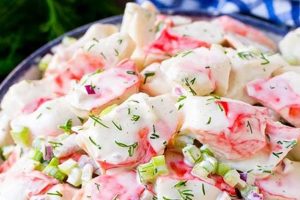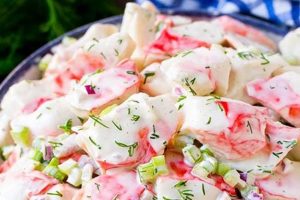A dish featuring premium-quality crab meat, often from the Jonah or Blue crab, lightly bound with mayonnaise and seasonings, and sometimes incorporating fresh vegetables and herbs. A classic presentation involves serving this delicacy chilled on lettuce cups, crackers, or as a sandwich filling.
This preparation showcases the delicate, sweet flavor of the crab. Its simplicity allows the natural taste of the crustacean to shine, making it a popular choice for appetizers, light lunches, or elegant dinners. Historically, crab has been a valued food source in coastal communities, and simple salads showcasing its flavor have likely been enjoyed for generations, evolving into the refined versions found today. The use of high-quality ingredients ensures a luxurious culinary experience.
This exploration will delve into various aspects of creating this culinary delight, including selecting the right crab meat, achieving the perfect balance of seasonings, and exploring creative variations to enhance the classic presentation.
Tips for Exquisite Crab Salad
Achieving optimal flavor and texture requires attention to detail. These tips offer guidance for creating a truly exceptional dish.
Tip 1: Select High-Quality Crab Meat: Opt for jumbo lump or lump crab meat, ensuring pristine white color and a delicate, sweet aroma. Avoid broken or shredded varieties for optimal presentation and texture.
Tip 2: Handle the Crab Gently: Minimize handling to avoid breaking delicate lumps. Fold ingredients together carefully, preserving the integrity of the crab meat.
Tip 3: Season Judiciously: Enhance, not overpower, the natural crab flavor. A light hand with seasonings such as Old Bay, celery salt, or fresh herbs allows the sweetness of the crab to shine.
Tip 4: Balance the Binder: Use high-quality mayonnaise sparingly, ensuring the crab remains the star. Greek yogurt or a light vinaigrette can be incorporated for a lighter, tangier alternative.
Tip 5: Incorporate Fresh Ingredients: Elevate the salad with finely diced celery, red onion, bell pepper, or fresh herbs like dill or parsley. These additions provide textural and flavor complexity.
Tip 6: Chill Thoroughly: Allow the flavors to meld by chilling the salad for at least 30 minutes before serving. This enhances the overall taste and provides a refreshing culinary experience.
Tip 7: Consider Presentation: Thoughtful presentation elevates the dining experience. Serve the salad on crisp lettuce cups, crackers, or as a sandwich filling. Garnish with fresh herbs or a lemon wedge.
By adhering to these guidelines, one can consistently achieve a superior crab salad that highlights the delicate flavor and texture of the premium ingredient.
These culinary insights pave the way for crafting a truly exceptional dish, perfect for any occasion.
1. High-quality lump crab meat
High-quality lump crab meat forms the foundation of an exceptional crab salad. Its impact extends beyond mere flavor; it influences texture, appearance, and overall culinary experience. The delicate, sweet taste of premium lump crab meat, typically sourced from Jonah or Blue crabs, requires minimal manipulation, allowing its natural characteristics to shine. Conversely, using lower-grade, shredded crab meat often results in a fishier flavor and a less appealing, mushy texture. For instance, a salad crafted with premium jumbo lump crab meat showcases large, intact pieces, offering a luxurious mouthfeel and a clean, briny flavor, unlike a salad made with backfin or claw meat, which tends to be more fragmented and less flavorful.
This distinction highlights the significance of ingredient selection. While cost considerations might tempt one toward less expensive options, the compromise in quality directly impacts the final product. A premium crab salad relies on the inherent sweetness and delicate texture of high-quality lump crab meat. Attempts to compensate for inferior ingredients through excessive seasoning or heavy binders often prove futile, masking rather than enhancing the overall flavor profile. One can readily observe this contrast by comparing a salad using premium lump crab meat against one using claw meat; the former offers a clean, bright flavor, while the latter often requires heavier seasoning to compensate for its inherent lack of sweetness.
Understanding the crucial role of high-quality lump crab meat is paramount for culinary success. It represents an investment in flavor and texture, ensuring the final dish delivers a truly exceptional experience. Substituting lower-quality crab meat invariably compromises the integrity of the salad, hindering the achievement of optimal results. The choice of crab meat, therefore, establishes the baseline for the entire culinary endeavor.
2. Minimal Handling
Minimal handling is crucial in preparing lump crab salad. The delicate nature of lump crab meat necessitates gentle treatment to maintain its structural integrity and prevent it from becoming mushy or stringy. Excessive handling compromises both the texture and the aesthetic appeal of the final dish. This careful approach preserves the natural flavors and ensures a visually appealing presentation.
- Preserving Texture:
Lump crab meat, prized for its delicate texture, consists of large, intact muscle fibers. Rough handling breaks these fibers, resulting in a less desirable, shredded consistency. Consider the difference between gently folding lump crab into a dressing versus vigorously mixing it. The former preserves the integrity of the lumps, while the latter results in a broken, less appealing texture. This textural difference significantly impacts the overall dining experience.
- Maintaining Appearance:
The visual appeal of lump crab salad lies in the distinct, large lumps of crab meat. Excessive handling disrupts these lumps, creating a less appetizing, homogenous mass. Imagine plating two salads: one where the crab meat is presented in beautiful, intact lumps, and another where the crab is shredded and broken. The visual contrast underscores the importance of minimal handling in achieving an elegant presentation.
- Enhancing Flavor:
While not directly impacting the inherent flavor of the crab, minimal handling preserves the structural integrity of the meat, which in turn allows it to absorb and showcase the flavors of the accompanying ingredients more effectively. Intact lumps provide a more substantial canvas for the dressing and other components, leading to a more balanced and enjoyable flavor profile. Conversely, over-handled, shredded crab tends to become saturated with the dressing, potentially overpowering the delicate crab flavor.
- Respecting the Ingredient:
Minimal handling reflects a respect for the quality and inherent characteristics of the lump crab meat. It acknowledges the premium nature of the ingredient and prioritizes showcasing its natural attributes rather than manipulating them. This approach aligns with culinary principles that emphasize highlighting the inherent qualities of high-quality ingredients. Much like handling fresh herbs or delicate greens, a gentle touch preserves the integrity and elevates the final dish.
In the context of lump crab salad, minimal handling is not merely a technique but a philosophy that prioritizes quality and elegance. From preserving the delicate texture and visual appeal to enhancing flavor delivery and demonstrating respect for the ingredient, minimal handling is essential for creating a truly exceptional lump crab salad. This careful approach distinguishes a thoughtfully prepared dish from one where the integrity of the core ingredient has been compromised.
3. Balanced Seasonings
Balanced seasonings play a pivotal role in a lump crab salad recipe. The delicate, sweet flavor of lump crab meat is easily overpowered. The objective is to enhance, not mask, this inherent sweetness. Over-seasoning, particularly with strong spices or excessive salt, can obscure the subtle nuances of the crab. Conversely, insufficient seasoning results in a bland, uninspired dish. The balance lies in judiciously using seasonings that complement the crab’s natural flavor profile. A classic example is the use of Old Bay seasoning. While offering a complex blend of spices, it should be applied sparingly to avoid overwhelming the crab. Similarly, fresh herbs, such as dill or chives, can add brightness but should be incorporated with restraint.
The interplay between acidity, salt, and other flavor components requires careful consideration. A touch of lemon juice or vinegar can provide a welcome brightness, cutting through the richness of the mayonnaise and highlighting the sweetness of the crab. Salt, crucial for enhancing flavors, must be balanced with the other seasonings and the inherent salinity of the crab itself. Consider a scenario where Dijon mustard is incorporated into the recipe. Its sharp, tangy notes must be carefully balanced against the other flavors to avoid creating a disharmony. Practical applications of this understanding involve tasting and adjusting throughout the preparation process. A small batch can be seasoned initially, tasted, and then adjusted to achieve the desired balance before incorporating the seasonings into the full batch of salad.
Achieving balanced seasonings ultimately elevates lump crab salad from simple to exceptional. It allows the inherent qualities of the premium ingredient to shine while adding depth and complexity. The challenge lies not in simply adding seasonings, but in understanding their interplay and how they interact with the delicate flavor of the crab. This meticulous approach distinguishes a thoughtfully prepared crab salad, showcasing culinary expertise and a deep appreciation for the nuanced flavors of this prized ingredient.
4. Appropriate Binder
The binder in a lump crab salad recipe is crucial. It provides cohesion, moisture, and contributes to the overall flavor profile. Selecting an appropriate binder involves careful consideration of its consistency, flavor, and how it interacts with the delicate crab meat. An overly heavy or strongly flavored binder can mask the subtle sweetness of the crab, while too little binder results in a dry, crumbly salad lacking structural integrity. The choice of binder ultimately dictates the final texture and taste, influencing the overall culinary experience.
- Mayonnaise: The Classic Choice
Mayonnaise is the traditional binder for lump crab salad, offering a creamy texture and rich flavor. However, the quality and quantity of mayonnaise significantly impact the final product. High-quality mayonnaise, made with natural ingredients, complements the crab without overpowering it. Using too much mayonnaise, even of high quality, creates a heavy, greasy salad that obscures the crab’s delicate taste. For example, using a light, homemade mayonnaise allows the crab to shine, while a thick, store-bought variety can dominate the flavor profile.
- Greek Yogurt: A Lighter Alternative
Greek yogurt provides a tangy, lighter alternative to mayonnaise. Its lower fat content contributes to a fresher, less heavy salad. The tanginess of the yogurt complements the sweetness of the crab, creating a balanced flavor profile. However, the consistency of Greek yogurt can be thinner than mayonnaise, requiring careful adjustment of the quantity to achieve the desired texture. One might combine Greek yogurt with a small amount of mayonnaise to achieve a balanced texture and flavor profile.
- Vinaigrettes: A Zesty Option
A light vinaigrette offers a refreshing and zesty alternative, particularly suitable for those seeking a lighter, less creamy salad. Lemon or lime juice based vinaigrettes enhance the natural sweetness of the crab while adding a bright, citrusy note. However, vinaigrettes typically provide less body than mayonnaise or yogurt, resulting in a looser salad. This characteristic can be advantageous for certain presentations, such as open-faced sandwiches or salads served over greens.
- Aioli: A Flavorful Enhancement
Aioli, essentially flavored mayonnaise, offers a more complex and robust flavor profile. Garlic aioli, for instance, adds a pungent depth that complements the sweetness of the crab. However, the strong flavors of aioli can easily overpower the delicate crab, requiring judicious use. Aioli is best suited for those seeking a more assertive flavor profile, and its creamy texture provides a good binding quality similar to traditional mayonnaise.
The choice of binder significantly impacts the final character of the lump crab salad. Whether opting for the classic richness of mayonnaise, the tangy lightness of Greek yogurt, the zesty brightness of a vinaigrette, or the flavorful complexity of aioli, the selected binder must complement, not compete with, the delicate flavor and texture of the lump crab meat. This careful selection ensures a harmonious balance of flavors and textures, creating a culinary experience that truly showcases the quality of the ingredients.
5. Fresh Ingredients
Fresh ingredients are essential for elevating lump crab salad beyond the ordinary. These components contribute not only textural complexity but also nuanced flavors that enhance the delicate sweetness of the crab. The interplay between fresh ingredients and the crab meat creates a dynamic sensory experience, transforming a simple salad into a culinary delight. Consider the crispness of finely diced celery against the soft texture of the crab, or the subtle bite of red onion contrasting with the crab’s sweetness. These textural and flavor contrasts create a more engaging and satisfying culinary experience.
The selection and preparation of fresh ingredients significantly impact the overall quality of the salad. Wilted herbs or overly pungent onions can detract from the delicate balance of flavors. Conversely, vibrant, freshly chopped herbs and finely diced vegetables enhance both the visual appeal and the palate experience. For example, incorporating freshly chopped dill provides a bright, herbaceous counterpoint to the richness of the crab, while the use of dried dill can result in a dull, less vibrant flavor profile. Similarly, using sweet, crisp bell peppers adds a refreshing crunch and subtle sweetness, whereas using older, less vibrant peppers can introduce an undesirable bitterness.
Understanding the vital role of fresh ingredients in lump crab salad is paramount for culinary success. These elements are not mere additions but integral components that contribute to a more nuanced and satisfying dish. The careful selection, preparation, and incorporation of fresh ingredients elevate the salad from simple fare to a refined culinary creation. This attention to detail distinguishes a thoughtfully crafted dish, reflecting a commitment to quality and an appreciation for the interplay of flavors and textures.
6. Thorough Chilling
Thorough chilling is an essential step in preparing lump crab salad, impacting both food safety and flavor development. Chilling allows the flavors of the various ingredientsthe delicate crab, the binder, the seasonings, and any added vegetables or herbsto meld and harmonize. This process enhances the overall complexity and balance of the final product. Moreover, thorough chilling is crucial for maintaining the safety of the crab meat, which is highly perishable. Chilling inhibits bacterial growth, ensuring the salad remains safe for consumption. A crab salad prepared and chilled for at least two hours before serving offers a more nuanced and balanced flavor profile compared to one served immediately after mixing.
The benefits of thorough chilling extend beyond mere flavor enhancement. Chilling firms the texture of the crab meat, improving the overall structure of the salad. This is particularly noticeable when using a lighter binder, such as a vinaigrette. Chilling helps the salad maintain its shape and prevents it from becoming watery or loose. Furthermore, the cold temperature enhances the refreshing qualities of the salad, making it particularly appealing in warmer weather. Consider a scenario where the salad is served at a picnic or outdoor gathering. A thoroughly chilled salad maintains its quality and appeal despite higher ambient temperatures, whereas a salad that hasn’t been adequately chilled may become unappetizing quickly. This practical aspect highlights the importance of chilling in various serving contexts.
Thorough chilling is not merely a final step but an integral part of the lump crab salad preparation process. It contributes significantly to both the flavor development and the safety of the dish. Understanding the importance of this step and implementing it correctly ensures a more enjoyable and safe culinary experience. Neglecting proper chilling can compromise the quality and safety of the salad, undermining the efforts put into selecting and preparing high-quality ingredients. Chilling, therefore, represents a crucial element in achieving a successful and satisfying lump crab salad.
7. Elegant Presentation
Elegant presentation elevates lump crab salad from a simple dish to a refined culinary experience. Visual appeal enhances enjoyment, transforming a casual meal into a special occasion. Presentation encompasses plating, garnishing, and the overall aesthetic of the dish. Consideration of these elements demonstrates care and attention to detail, reflecting the quality of the ingredients and the skill of the preparer.
- Plating Choices: Showcasing the Salad
The choice of serving vessel significantly impacts the visual appeal. Classic options include crisp lettuce cups, which provide a fresh, natural backdrop for the salad. Alternatively, serving the salad on endive spears or cucumber rounds adds a touch of elegance and textural contrast. Crackers or toasted baguette slices offer a crunchy base, providing a textural counterpoint to the creamy salad. For a more formal presentation, consider individual ramekins or small, elegant bowls. The plating choice should complement the overall style of the meal and the occasion.
- Garnishes: Enhancing Visual Appeal
Garnishes provide visual interest and enhance the flavors of the salad. Fresh herbs, such as sprigs of dill, chives, or parsley, add a vibrant touch of color and a delicate aroma. A sprinkle of paprika or a dusting of Old Bay seasoning can add a pop of color and reinforce the flavor profile. Thinly sliced lemon wedges not only add visual appeal but also offer a burst of fresh citrus flavor. The key is to choose garnishes that complement the flavors of the salad without overpowering the delicate crab meat.
- Color and Contrast: Creating Visual Interest
A visually appealing dish often incorporates contrasting colors and textures. The creamy white of the crab meat can be accentuated by vibrant green herbs, bright red bell peppers, or the deep green of avocado slices. These color contrasts create a more dynamic and engaging presentation. Consider the difference between a monochromatic salad and one with varied hues. The latter stimulates the appetite and enhances the overall dining experience.
- Context and Occasion: Adapting the Presentation
The appropriate level of elegance varies depending on the context. A casual lunch may call for a simple presentation in lettuce cups or on crackers. A more formal dinner party might warrant a more elaborate presentation, using elegant serving dishes and carefully arranged garnishes. Adapting the presentation to the occasion ensures the dish complements the overall dining experience. For example, serving the salad as an appetizer at a cocktail party might involve using miniature spoons or small, elegant serving vessels to facilitate easy consumption.
Elegant presentation enhances the enjoyment of lump crab salad. By considering the plating, garnishes, color contrast, and context, one can transform a simple dish into a culinary masterpiece. These seemingly small details demonstrate a commitment to quality and elevate the entire dining experience, reflecting the care taken in selecting and preparing the ingredients. The visual appeal complements the delicate flavors of the crab salad, creating a harmonious and satisfying culinary experience.
Frequently Asked Questions
This section addresses common inquiries regarding the preparation and enjoyment of lump crab salad.
Question 1: What is the best type of crab meat for lump crab salad?
Jumbo lump or lump crab meat from Jonah or Blue crabs is recommended for its delicate flavor and texture. These grades offer the largest, most intact pieces, ideal for showcasing the quality of the crab.
Question 2: Can pasteurized crab meat be used?
Pasteurized crab meat is a safe and convenient option. It undergoes a heating process to eliminate potential pathogens while retaining flavor and texture, suitable for those concerned about food safety.
Question 3: How much mayonnaise should be used?
Mayonnaise should be used sparingly. The goal is to bind the ingredients without masking the delicate crab flavor. Start with a small amount and add more as needed, prioritizing the flavor of the crab.
Question 4: What seasonings complement lump crab meat?
Old Bay, celery salt, fresh dill, chives, and parsley complement lump crab. Use seasonings judiciously, allowing the natural sweetness of the crab to shine through. A touch of lemon juice or Dijon mustard can add brightness and complexity.
Question 5: How long should the salad be chilled?
Chilling for at least 30 minutes, or preferably longer, allows the flavors to meld and enhances the overall experience. Thorough chilling is also crucial for food safety.
Question 6: How long can lump crab salad be stored?
Refrigerate promptly in an airtight container. Consume within one to two days for optimal flavor and quality. Monitor for any signs of spoilage before consuming.
Addressing these frequently asked questions provides a foundation for creating and enjoying lump crab salad successfully. Understanding the nuances of preparation ensures a satisfying culinary experience.
This information provides a comprehensive overview. The subsequent sections delve further into specific aspects of creating this culinary delight.
Lump Crab Salad Recipe
Exploration of lump crab salad recipes reveals that achieving culinary excellence hinges on a combination of factors: prioritizing high-quality ingredients, employing delicate handling techniques, achieving a balance of seasonings, selecting an appropriate binder, incorporating fresh complementary elements, ensuring thorough chilling, and attending to elegant presentation. Each component contributes to the final product, impacting flavor, texture, and overall dining experience. From the selection of premium lump crab meat to the final garnish, careful consideration distinguishes a truly exceptional crab salad.
Mastery of lump crab salad preparation signifies not only culinary skill but also an appreciation for the delicate nuances of this prized ingredient. The pursuit of excellence in this seemingly simple dish unlocks a deeper understanding of flavor balance, texture interplay, and the transformative power of thoughtful preparation. This culinary endeavor serves as a testament to the potential for achieving extraordinary results through careful attention to detail and a commitment to quality ingredients.

